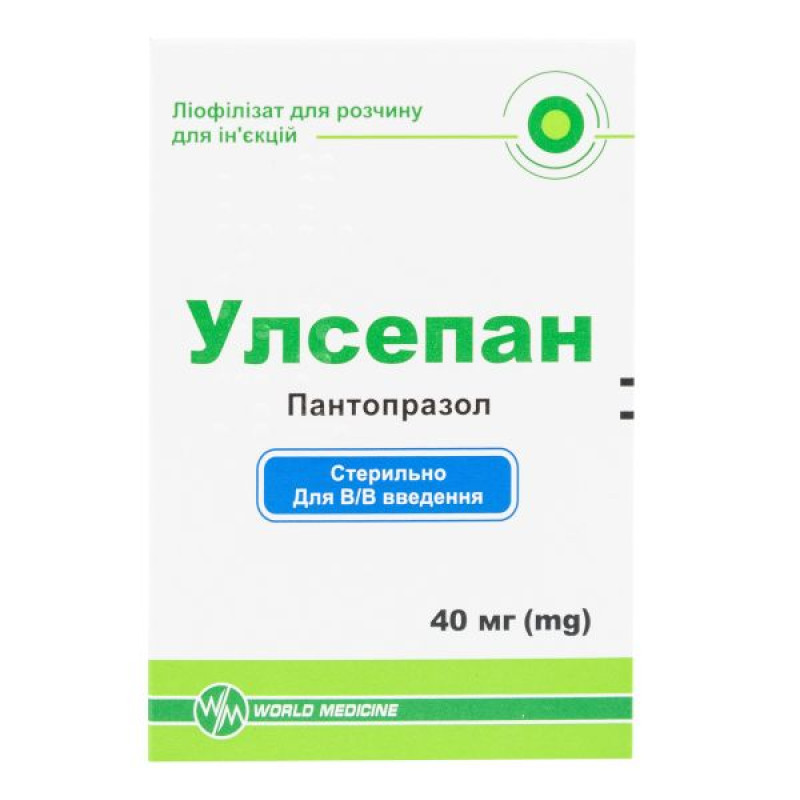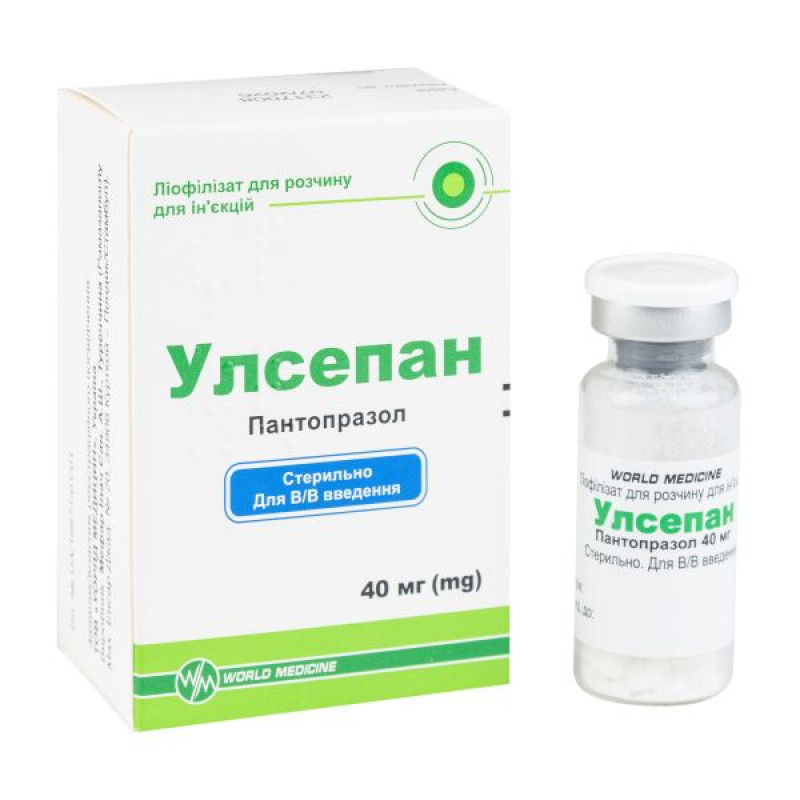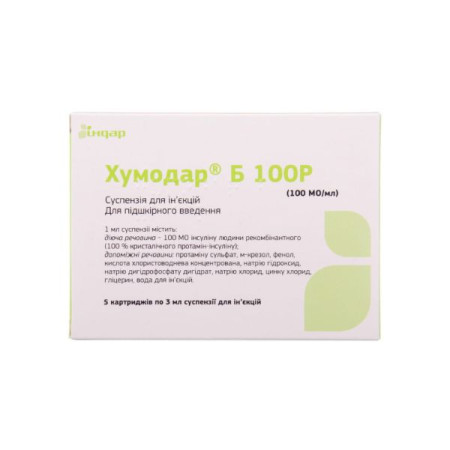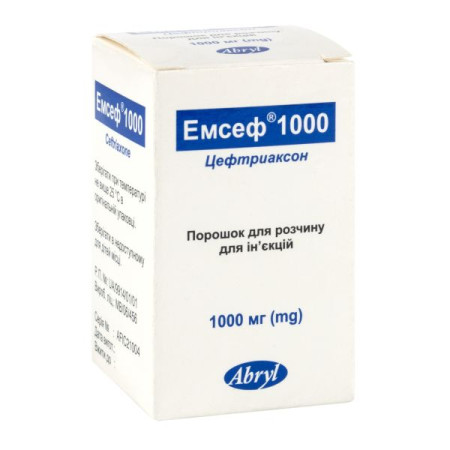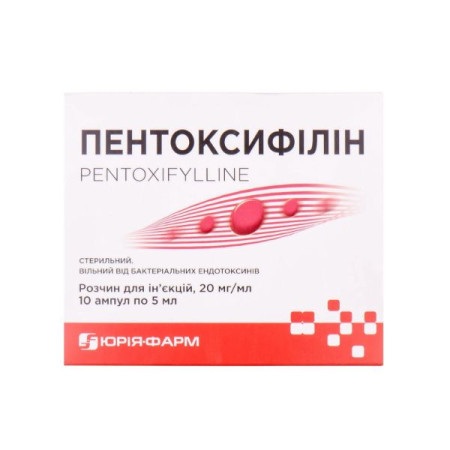Ulsepan lyophilized powder for solution for injection 40 mg vial No. 1
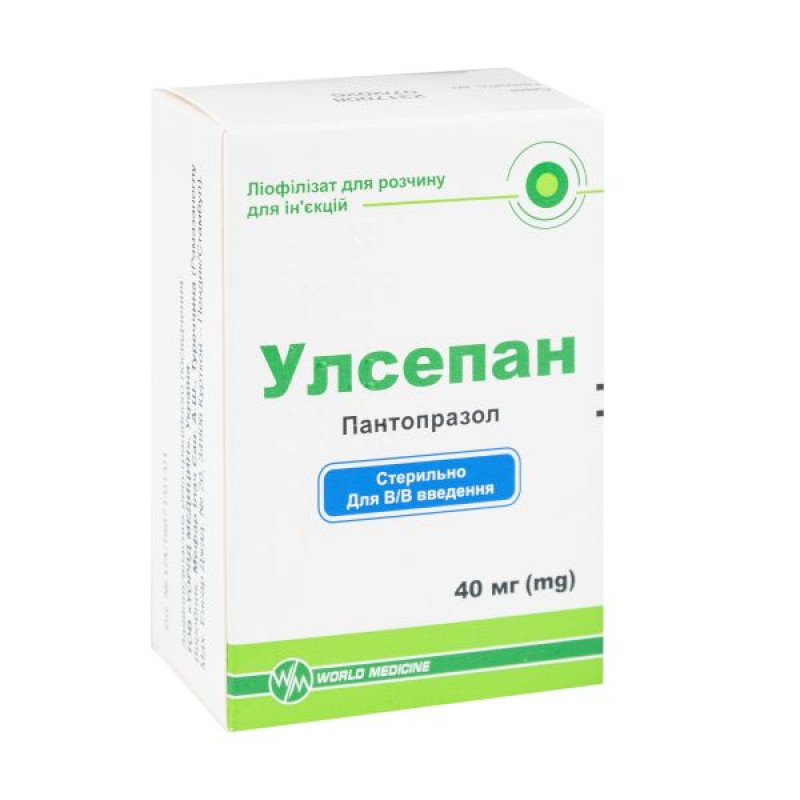
Instructions for use Ulsepan lyophilized powder for solution for injection 40 mg vial No. 1
Composition
active ingredient: pantoprazole;
1 bottle contains pantoprazole (in the form of pantoprazole sodium sesquihydrate) 40 mg.
Dosage form
Lyophilisate for solution for injection.
Main physicochemical properties: lyophilized powder of white or almost white color.
Pharmacotherapeutic group
A drug for the treatment of peptic ulcers; a proton pump inhibitor.
ATX code A02B C02.
Pharmacological properties
Pharmacodynamics.
Pantoprazole inhibits the secretion of hydrochloric acid in the stomach by specifically affecting the proton pump of parietal cells.
Pantoprazole is converted to its active form in an acidic environment, namely in the parietal cells of the stomach, where it inhibits H+/K+-ATPase, i.e. the final phase of hydrochloric acid formation, regardless of the nature of the stimulus that stimulates its formation. Inhibition is dose-dependent and affects basal and stimulated secretion of gastric juice. Treatment with pantoprazole reduces the level of gastric acidity, which proportionally leads to an increase in gastrin secretion. The increase in gastrin levels is reversible. Since pantoprazole binds to enzymes that are distant from cell receptors, it affects the secretion of hydrochloric acid regardless of stimulation by other substances (acetylcholine, histamine, gastrin).
Pharmacokinetics.
The volume of distribution is 0.15 l/kg, its clearance is approximately 0.1 l/h/kg. The half-life is 1 hour. Due to the specific activation of pantoprazole in parietal cells, the half-life does not correlate with the duration of action (inhibition of acid secretion).
The pharmacokinetics are unchanged after single or multiple administration. In the dose range of 10 to 80 mg, the pharmacokinetics of pantoprazole remain linear after both oral and intravenous administration.
Serum protein binding is 98%. The drug is metabolized in the liver. The main route of excretion of metabolites is renal (almost 80%), 20% is excreted in the feces. The main metabolite in both serum and urine is desmethylpantoprazole, bound to sulfate. The half-life of the main metabolite (1.5 hours) is not much longer than that of pantoprazole.
Pharmacokinetics in selected patient groups. Patients with impaired renal function (including patients on hemodialysis) do not require a reduction in the dose of pantoprazole. As in healthy subjects, the half-life of pantoprazole in these patients is short. Very little pantoprazole is dialyzed. Although the half-life of the main metabolite is slightly increased (2-3 hours), it is rapidly excreted and therefore does not accumulate.
Although in patients with liver cirrhosis (Child class A and B) the half-life of the active substance increases to 7-9 hours and the AUC increases accordingly, the maximum concentration of pantoprazole in plasma increases only 1.5 times compared to healthy subjects.
The slight increase in AUC and Cmax in elderly patients compared to younger patients is not clinically significant.
Indication
Reflux esophagitis.
Duodenal ulcer.
Stomach ulcer.
Zollinger-Ellison syndrome and other hypersecretory pathological conditions.
Contraindication
Hypersensitivity to pantoprazole, benzimidazole derivatives or to any component of the drug.
Interaction with other medicinal products and other types of interactions
Effect of pantoprazole on the absorption of other medicinal products. Due to the complete and long-term inhibition of hydrochloric acid secretion, pantoprazole may reduce the absorption of medicinal products whose bioavailability depends on the pH of the gastric juice (e.g. some antifungals such as ketoconazole, itraconazole, posaconazole, or other medicinal products such as erlotinib).
Anti-HIV drugs (atazanavir). Concomitant use of proton pump inhibitors with atazanavir and other anti-HIV drugs whose absorption depends on gastric pH may significantly reduce the bioavailability of the latter and affect their efficacy. Therefore, concomitant use of proton pump inhibitors with atazanavir is not recommended.
Coumarin anticoagulants (phenprocoumon and warfarin). Although no interaction was observed with concomitant administration of phenprocoumon and warfarin in clinical trials, isolated cases of changes in INR (International Normalized Ratio) have been reported in the post-marketing period. Therefore, in patients taking coumarin anticoagulants (e.g. phenprocoumon and warfarin), it is recommended that prothrombin time/INR be monitored after initiation, discontinuation or irregular administration of pantoprazole.
Other interactions. Pantoprazole is extensively metabolised in the liver via the cytochrome P450 enzyme system. The main route of metabolism is demethylation by CYP2C19 and other metabolic pathways, including oxidation by CYP3A4. Studies with medicinal products also metabolised by these pathways, such as carbamazepine, diazepam, glibenclamide, nifedipine and oral contraceptives containing levonorgestrel and ethinylestradiol, have not revealed any clinically significant interactions.
The results of a number of studies on possible interactions indicate that pantoprazole does not affect the metabolism of active substances metabolized by CYP1A2 (e.g. caffeine, theophylline), CYP2C9 (e.g. piroxicam, diclofenac, naproxen), CYP2D6 (e.g. metoprolol), CYP2E1 (e.g. ethanol), and does not affect p-glycoprotein, which is associated with the absorption of digoxin.
No interactions with concomitantly administered antacids were identified.
Studies have been conducted to study the interaction of pantoprazole with certain antibiotics (clarithromycin, metronidazole, amoxicillin) administered concomitantly. No clinically significant interactions between these drugs have been identified.
Application features
Alarming symptoms present. In the presence of alarming symptoms (e.g. significant unintentional weight loss, recurrent vomiting, dysphagia, haematemesis, anaemia, melena) and in the presence or suspicion of gastric ulcer, malignancy should be excluded, as treatment with pantoprazole may mask symptoms and delay diagnosis. If symptoms persist despite adequate treatment, further investigation is necessary.
Hepatic impairment: Patients with severe hepatic impairment should have their liver enzymes monitored regularly. If liver enzymes increase, treatment with the drug should be discontinued.
Concomitant use with atazanavir. Concomitant use of atazanavir with proton pump inhibitors is not recommended (see section 4.5). If the combination of a PPI with atazanavir is necessary, close clinical monitoring (e.g. viral load measurement) should be performed in conjunction with an increase in the dose of atazanavir to 400 mg with 100 mg ritonavir. The dose of pantoprazole should not exceed 20 mg daily.
Gastrointestinal infections caused by bacteria. Pantoprazole, like other proton pump inhibitors, may increase the number of bacteria normally present in the upper gastrointestinal tract. Treatment with the drug may slightly increase the risk of gastrointestinal infections caused by bacteria such as Salmonella and Campylobacter or C. Difficile.
Hypomagnesemia: Severe hypomagnesemia has been reported in patients treated with PPIs such as pantoprazole for at least three months, and in most cases for a year. The following serious clinical manifestations of hypomagnesemia may occur and may initially be insidious: fatigue, tetany, delirium, convulsions, dizziness and ventricular arrhythmias. In the case of hypomagnesemia, the majority of patients improved after magnesium replacement therapy and discontinuation of the PPI.
Patients requiring long-term therapy or patients taking PPIs concomitantly with digoxin or drugs that may cause hypomagnesemia (e.g., diuretics) should have their magnesium levels measured before starting PPI treatment and periodically during treatment.
Bone fractures. Long-term treatment (more than 1 year) with high doses of proton pump inhibitors may slightly increase the risk of hip, wrist and spine fractures, mainly in the elderly or in the presence of other risk factors. Observational studies suggest that the use of proton pump inhibitors may increase the overall risk of fractures by 10-40%. Some of these may be due to other risk factors. Patients at risk of osteoporosis should be treated according to current clinical guidelines and consume adequate amounts of vitamin D and calcium.
Use during pregnancy or breastfeeding
Pregnancy. Experience with the drug in pregnant women is limited. Reproductive toxicity has been observed in animal reproduction studies. The potential risk to humans is unknown. Ulsepan should not be used during pregnancy unless clearly necessary.
Breastfeeding. Animal studies have shown excretion of pantoprazole in breast milk. There are data on the excretion of pantoprazole in human breast milk. A decision must be made whether to discontinue breast-feeding or to discontinue/abstain from Ulsepan therapy taking into account the benefit of breast-feeding for the child and the benefit of Ulsepan therapy for the woman.
Ability to influence reaction speed when driving vehicles or other mechanisms
It is necessary to take into account the possible development of adverse reactions, such as dizziness and visual disturbances. In the event of the development of such reactions, driving or other mechanisms should be avoided.
Method of administration and doses
The drug should be used by adults as directed and under the direct supervision of a physician. Intravenous administration of the drug is recommended only if oral administration is not possible. Available safety data refer to intravenous administration for up to 7 days. Therefore, if clinically feasible, a switch from intravenous to oral administration of pantoprazole should be made.
Dosage.
Reflux esophagitis, duodenal ulcer, gastric ulcer.
The drug should be administered intravenously at a dose of 40 mg (1 vial) per day.
Zollinger-Ellison syndrome and other hypersecretory pathological conditions.
The drug should be used at the recommended initial dose of 80 mg per day. If necessary, the dose can be titrated up or down, depending on the indicators of acid secretion in the stomach. Doses exceeding 80 mg per day should be divided into two administrations. A temporary increase in the dose of pantoprazole to more than 160 mg is possible, but the duration of use should be limited only to the period necessary for adequate control of acid secretion.
If rapid reduction of acidity is required, an initial dose of 2 x 80 mg is sufficient for most patients to achieve the desired level (< 10 mEq/h) within 1 hour.
Liver failure.
Patients with severe liver dysfunction should not exceed a daily dose of 20 mg (½ vial of the drug).
Kidney failure.
Patients with impaired renal function do not require dose adjustment.
Elderly patients.
There is no need for dosage adjustment.
Method of application.
Dissolve the powder in 10 ml of 0.9% sodium chloride solution. The solution can be administered directly or after mixing with 100 ml of 0.9% sodium chloride solution or 5% glucose solution in plastic or glass bottles.
After dilution, chemical and physical in-use stability has been demonstrated for 12 hours at 25°C. From a microbiological point of view, the diluted product should be used immediately.
The drug cannot be prepared or mixed with solvents other than those specified above.
Intravenous administration of the drug should be carried out over 2-15 minutes.
The vial is for single use only. Before use, the vials with the drug should be visually inspected (in particular, for discoloration, the presence of sediment).
The diluted solution should be colorless or have a pale yellow color.
Children.
There is insufficient experience with the use of the drug in the treatment of children, therefore the use of the drug in children (under 18 years of age) is not recommended.
Overdose
Symptoms of overdose are unknown.
Doses up to 240 mg administered intravenously over 2 minutes have been well tolerated. Since pantoprazole is extensively protein bound, it is not a drug that can be readily dialyzed.
In case of overdose with clinical signs of intoxication, symptomatic and supportive therapy is used. There are no specific therapy recommendations.
Side effects
Adverse effects are classified by frequency of occurrence into the following categories: very common (≥ 1/10), common (≥ 1/100 and < 1/10), uncommon (≥ 1/1000 and < 1/100), rare (≥ 1/10000 and < 1/1000), very rare (< 1/10000), unknown (frequency not determined based on available data).
From the blood and lymphatic system.
Rare: agranulocytosis.
Very rare: leukopenia, thrombocytopenia, pancytopenia.
From the immune system.
Rare: hypersensitivity reactions (including anaphylactic reactions, anaphylactic shock).
Metabolism and metabolic disorders.
Rare: hyperlipidemia and increased lipid levels (triglycerides, cholesterol), changes in body weight.
Not known: hyponatremia, hypomagnesemia (see section "Special warnings and precautions for use"), hypocalcemia1, hypokalemia.
Mental disorders.
Uncommon: sleep disorders.
Rare: depression (including exacerbation).
Very rare: disorientation (including exacerbation).
Not known: hallucination, confusion (especially in patients with a predisposition to these disorders, as well as exacerbation of these symptoms in case of pre-existing conditions).
From the nervous system.
Uncommon: headache, dizziness.
Rare: taste disorders.
Not known: paraesthesia.
From the organ of vision.
Rare: visual disturbances/blurred vision.
From the digestive tract.
Uncommon: diarrhoea, nausea, vomiting, abdominal bloating, constipation, dry mouth, abdominal pain and discomfort.
On the part of the hepatobiliary system.
Uncommon: increased liver enzymes (transaminases, g-GT).
Rare: increased bilirubin levels.
Not known: hepatocyte damage, jaundice, hepatocellular failure.
On the skin and subcutaneous tissue.
Uncommon: skin rash, exanthema, pruritus.
Rare: urticaria, angioedema.
Not known: Stevens-Johnson syndrome, Lyell's syndrome, erythema multiforme, photosensitivity.
On the part of the musculoskeletal system and connective tissue.
Uncommon: fractures of the hip, wrist, spine (see section "Special warnings and precautions for use").
Rare: arthralgia, myalgia.
Not known: muscle spasm2.
On the part of the kidneys and urinary system.
Not known: interstitial nephritis (with possible development of renal failure).
From the reproductive system and mammary glands.
Rare: gynecomastia.
General disorders.
Common: thrombophlebitis at the injection site.
Rare: fever, peripheral edema.
1. Hypocalcemia simultaneously with hypomagnesemia.
2. Muscle spasm as a result of electrolyte imbalance.
Expiration date
3 years.
Storage conditions
Store at a temperature not exceeding 25 °C, protected from light and out of the reach of children. Do not freeze.
Packaging
1 vial with lyophilisate for solution for injection in a contour blister pack, 1 contour blister pack in a cardboard box.
Vacation category
According to the recipe.
Producer
SIGMATEK Pharmaceutical Industries
SIGMATEC Pharmaceutical Industries.
Address
Part B1 Industrial Zone No. 6-6 October City, Egypt
Part B1 - Industrial zone No. 6-6th October city, Egypt.
Applicant
WORLD MEDICINE LIMITED, United Kingdom.
WORLD MEDICINE LIMITED, United Kingdom.
There are no reviews for this product.
There are no reviews for this product, be the first to leave your review.
No questions about this product, be the first and ask your question.







